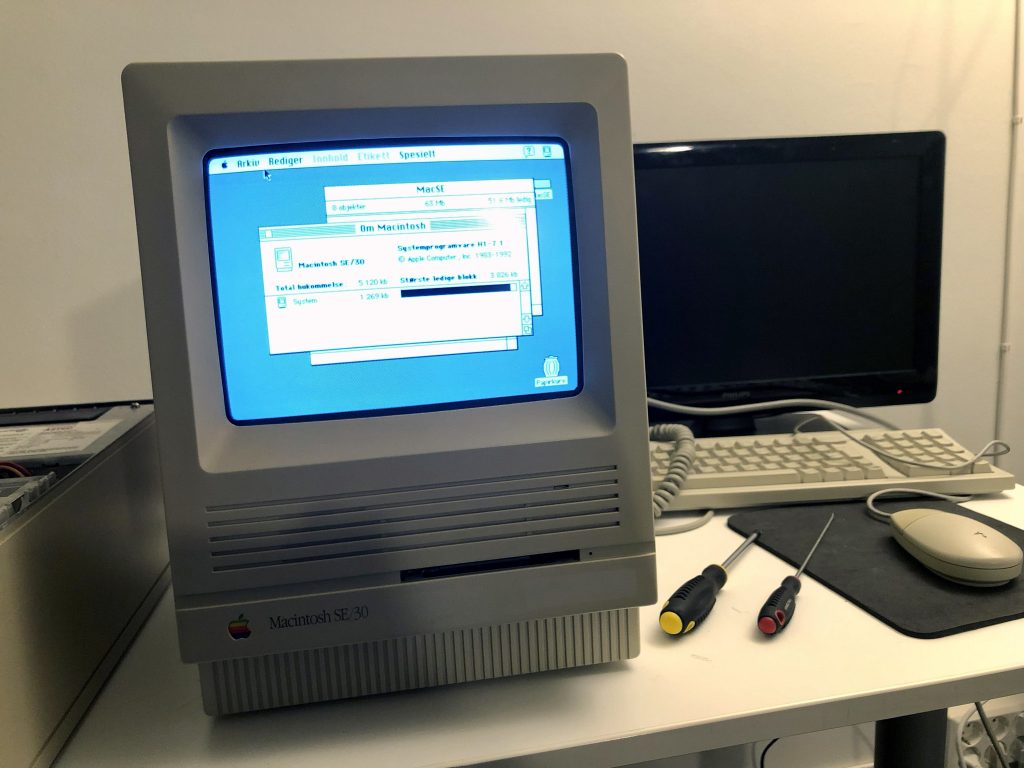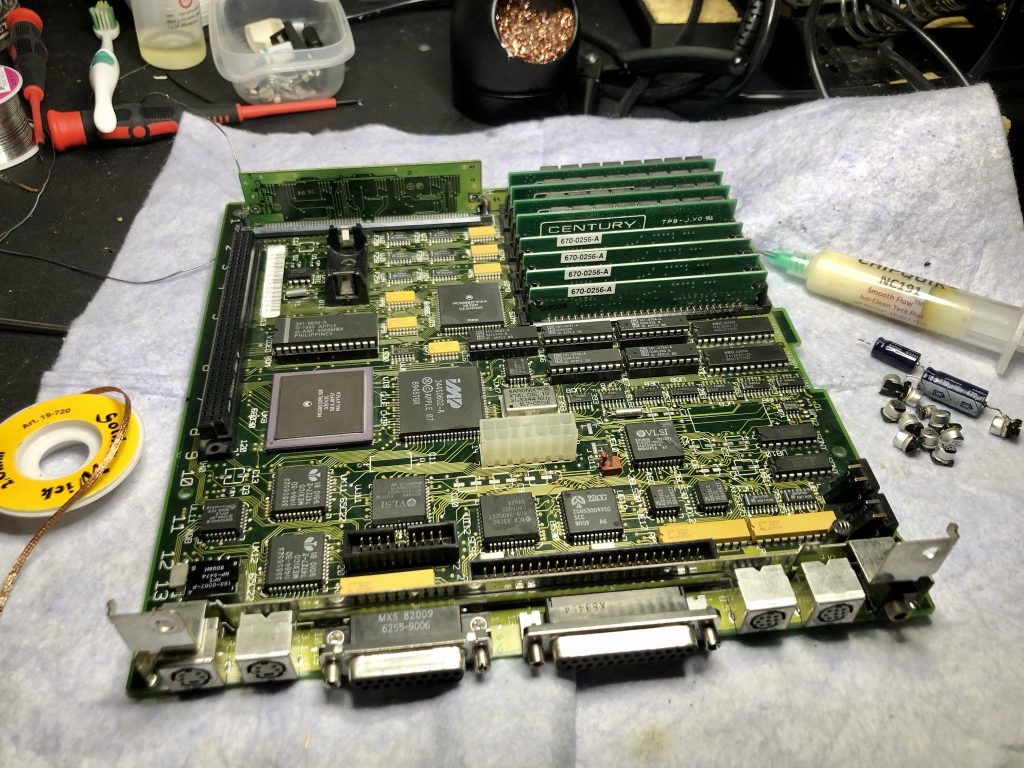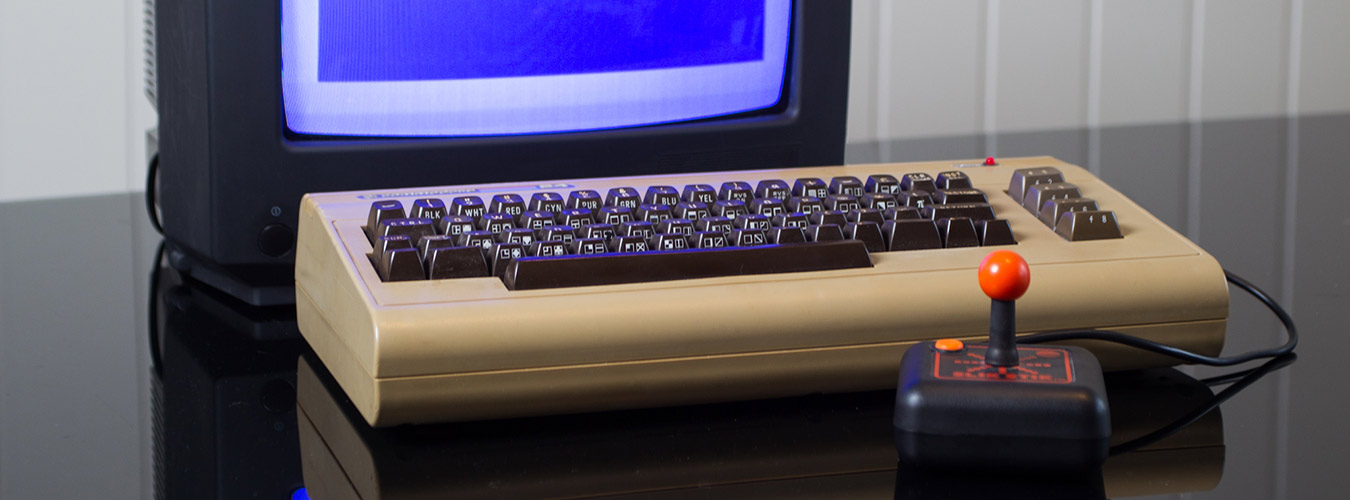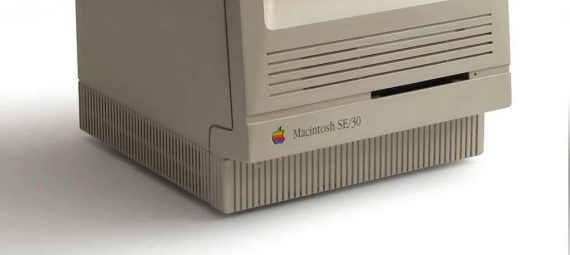Released 1989: The Macintosh SE/30 is a personal computer manufactured and sold by Apple Computer from January 1989 to October 1991. It is the fastest of the original black-and-white compact Macintosh series.
Facts
- Type: All-in-one
- Manufacturer: Apple Computer
- Product family: Compact Macintosh
- Released: 1989
- Discontinued: 1991
- OS: System 6.0.3 – 7.5.5
- Introductory price: $4369 (1 MB RAM, no hard disk)
- CPU: 68030 @ ~¨16 MHz
- Memory: 1 or 4 MB RAM (upgradable to 5 MB)
- Graphics: 512 x 342 pixel, 1 bit
- Audio: 8-bit mono 22 kHz
- Display: 9″ black and white CRT
- Internal storage: optional 3.5″ 40 or 80 MB SCSI HD
- Removable storage: 1 or 2, 3.5″ FD (1.44 MB)
- ROM 256 KB
- Dimensions: 13.6″ x 9.6″ x 10.9″
- Weight: 19.5 lb (8.8 kg)
- Predecessor: Macintosh SE
- Successor: Macintosh Classic II
The SE/30 has a black-and-white monitor and a single Processor Direct Slot (rather than the NuBus slots of the IIx, with which the SE/30 shares a common architecture) which supported third-party accelerators, network cards, or a display adapter. It was the first compact Mac to include a 1.44 MB high density floppy disk drive as standard (later versions of the SE also had one). The power of the SE/30 was demonstrated by its use to produce the This Week newspaper, the first color tabloid newspaper in the UK to use new, digital pre-press technology on a personal, desktop computer. In keeping with Apple’s practice, from the Apple II+ until the Power Macintosh G3 was announced, a logic board upgrade was available for $1699 to convert a regular SE to an SE/30. The SE would then have exactly the same specs as an SE/30, with the difference only in the floppy drive if the SE only had an 800 KB drive. The set included a new front bezel to replace the original SE bezel with that of an SE/30.
This machine was followed in 1991 by the Macintosh Classic II, which, despite the same processor and clock speed, was only 60% as fast as the SE/30 due to its 16-bit system bus, lacked an internal expansion slot, and made the Motorola 68882 FPU an optional upgrade.
Reception
Bruce F. Webster wrote in Macworld in March 1989 that the SE/30 did not “break new ground. It does, however, establish Apple’s commitment to the classic Mac product line, and it provides users with an Apple-supported alternative to either a small, slow Mac or a large, powerful one. More important, it fills a gap in the Macintosh family, a new level of power and portability for the Macintosh community”.
In a January 2009 Macworld feature commemorating the 25th anniversary of the Macintosh, three industry commentators – Adam C. Engst of TidBITS, John Gruber of Daring Fireball, and John Siracusa of Ars Technica – chose the SE/30 as their favorite Mac model of all time. “Like any great Mac,” wrote Gruber, “the SE/30 wasn’t just a terrific system just when it debuted; it remained eminently usable for years to come. When I think of the original Mac era, the machine in my mind is the SE/30.”

My Macintosh SE/30 and repair
My Macintosh SE/30 turned on, but wouldn’t always boot and the display had some distortion in the upper part. This model got surface mounted (SMD) electrolytic capacitors that tend to leak and loose its attributes over time. So motherboard must always be cleaned and capacitors replaced on this model.
- Cleaned motherboard with alcohol (isopropanol)
- Replaced all electrolytic capacitors
- Re-soldered/reflowed solder pads on analog board for the screen, connectors and fly-back transformer.
- Cleaned reader head on floppy drive with alcohol.
After this, machine works 100%. No distortion on the display anymore and boots up every time.



I have an SE/30, an SE, A Laserwriter NTX with an upgraded motherboard, a Mac G3, and pleanty of Mac keyboards and serial mice. interested?
Not very interested as shiping will cost. But thank you for offer.